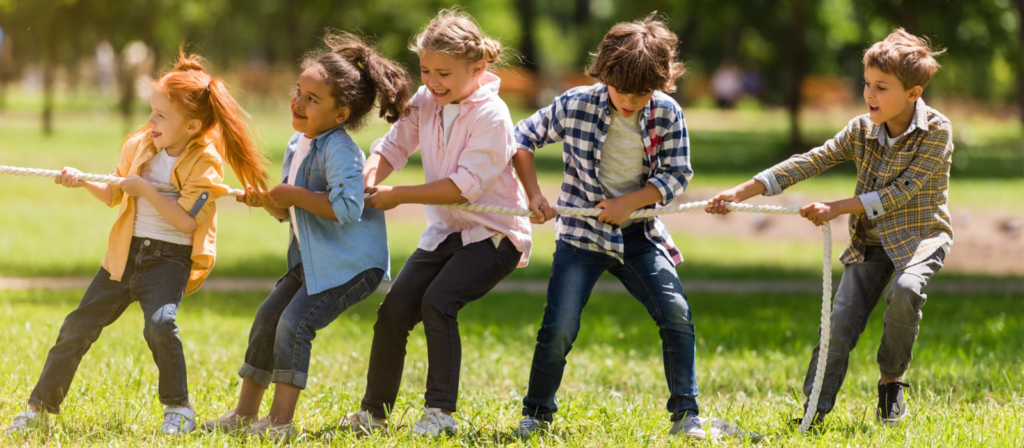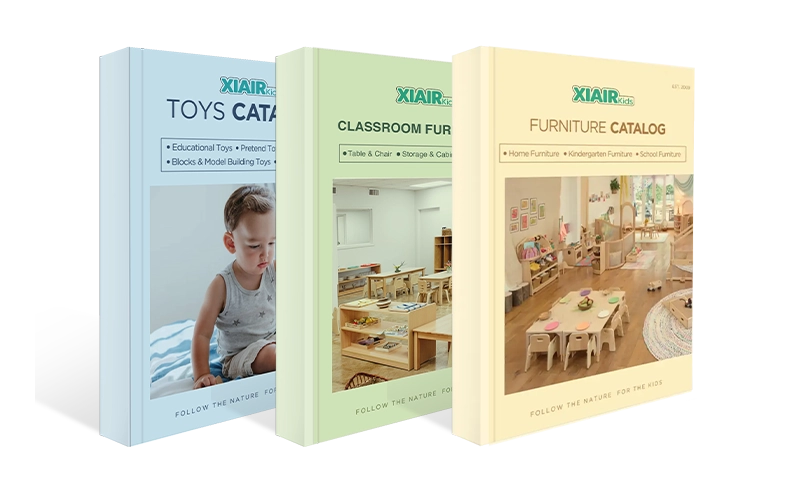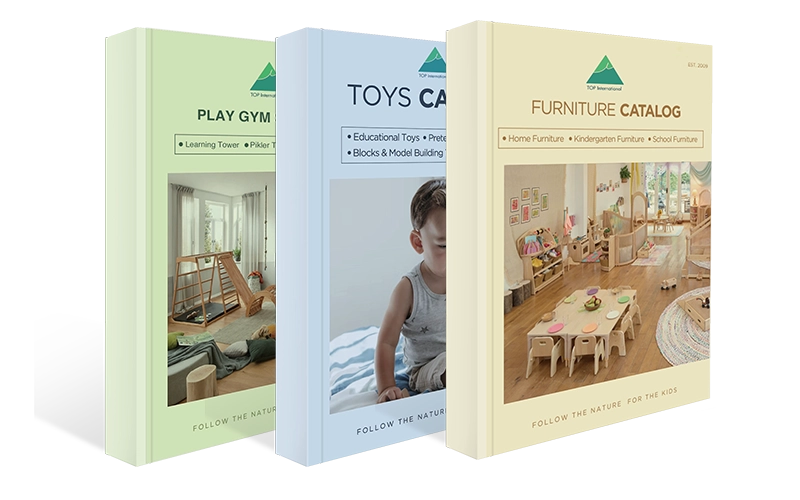Have you noticed how children naturally come together to play, build things, solve puzzles, or share toys? Why do some children excel at teamwork while others struggle to collaborate? Cooperative play could be the key to helping children develop essential social and cognitive skills.
As researcher Mildred Parten defines it, cooperative play is the final stage in which children work toward a common goal. This stage is essential for fostering strong social bonds, empathy, and interpersonal skills. Through cooperative play, children learn valuable lessons. They practice sharing, turn-taking, and understanding different perspectives, foundational for their emotional and social development.
So, how can cooperative play shape a child’s future? Let’s dive into cooperative play’s definition, benefits, and impact on children’s growth.

6 Stages of Play Development
Play is a crucial part of childhood development, and understanding the different stages helps us see how children grow socially, emotionally, and cognitively. Psychologist Mildred Parten identified six stages of play, which evolve as children develop. These stages provide a framework for understanding how children’s play becomes more social and interactive as they grow older:
- اللعب غير المشغول: Infants observe their surroundings without engaging in specific play.
- اللعب الانفرادي: Children play alone, focusing on their activities.
- لعبة المتفرج: Children watch others play but don’t participate.
- اللعب الموازي: Children play side by side, using similar materials but without interaction.
- اللعب الترابطي: Children interact and share toys, but don’t have a shared goal.
- اللعب التعاوني: Children work together toward a common goal, collaborating and problem-solving.

These stages illustrate the natural progression of play, from solitary activities to more complex and social forms of interaction, such as cooperative play.

Receive a free catalog and custom layout to help you design your ideal classroom easily.
What is Cooperative Play?
Cooperative play is when children work toward a common goal, engaging in activities that require collaboration and shared effort. In this type of play, children communicate, negotiate, and problem-solve with their peers, contributing their ideas and resources to achieve a shared objective. It is a key aspect of social development, as it helps children build strong social bonds, foster empathy, and learn to navigate interpersonal dynamics. Through cooperative play, children also develop essential skills such as turn-taking, compromise, and respect for others’ perspectives, which lay the foundation for effective communication and teamwork throughout life.
Difference between Cooperative Play and Associative Play
While both cooperative play and associative play involve interactions between children, they differ in structure and depth of engagement. In associative play, children may engage in similar activities and share materials, but do not work together toward a common goal. For example, children playing alongside each other with blocks or dolls might be engaging in associative play, as they share the toys but do not collaborate on a shared objective. On the other hand, cooperative play involves a deeper level of interaction, where children actively collaborate, create shared rules, and work toward a common goal. In collaborative play, the group dynamic is key, and the play’s success often depends on everyone’s participation and contribution.


Examples of Cooperative Play
- Building a tower: Children stack blocks and create a structure.
- Role-playing games: Children take on roles (e.g., family, doctor, or teacher) and collaborate in storytelling.
- Team sports: Children play games like soccer or basketball, working together to achieve a common goal.
- Group puzzles: Children solve puzzles together, discussing and contributing ideas.
- Collaborative art projects: Children create artwork together, sharing materials and ideas.
When Does Cooperative Play Begin?
Cooperative play typically begins around age 4 to 5, though this can vary depending on the child and their social environment. Children become more aware of others’ thoughts and feelings at this age, and their ability to communicate and collaborate improves significantly. They enjoy structured group activities where working together is necessary, such as building something as a team, creating stories through pretend play, or playing simple group games with rules.

This developmental shift is influenced by both cognitive growth and increased social exposure. As language skills strengthen and emotional understanding deepen, children become more capable of negotiating, sharing leadership, and solving conflicts—all essential in cooperative play. A supportive environment—at home or in a preschool setting—can encourage this interaction earlier or make it more meaningful.
While cooperative play usually emerges in preschool, it develops well into later childhood and becomes more complex as children grow.
Why is Cooperative Play Important?
Cooperative play is more than just children playing together—it’s a robust learning process that supports a child’s overall development. It shapes how children relate to others, handle emotions, and solve problems. In the context of early education, cooperative play lays the foundation for essential life skills such as empathy, teamwork, communication, and leadership. These are not traits children are born with—they are learned, practiced, and strengthened through meaningful, shared play experiences.

التطور الاجتماعي والعاطفي
When children engage in cooperative play, they understand how their actions affect others. Playing together builds empathy, patience, and a sense of responsibility. As children take on different roles, share ideas, and support one another, they become more emotionally aware and socially competent. These interactions help children feel connected and confident within a group, forming the basis of healthy relationships.
Conflict Resolution and Communication
Cooperative play naturally introduces moments of disagreement and difference in opinion. These situations allow children to practice resolving conflict, listening to others, and expressing themselves clearly. Over time, they learn how to work through frustration and reach a compromise, strengthening their communication skills and emotional regulation.
Foundation for Future Collaboration
The habits and mindsets developed during cooperative play carry into future learning and working environments. Children who experience effective collaboration early are better prepared for group projects in school, team sports, and eventually workplace teamwork. Cooperative play teaches them the value of working toward a shared goal, recognizing different strengths, and contributing meaningfully within a team.

How to Promote Cooperative Play?
Promoting cooperative play in children fosters teamwork, communication, and social development. Here are some practical strategies for encouraging cooperative play both in the classroom and at home:
Create Collaborative Activities
Design activities that require children to work together toward a shared goal. Games, puzzles, or group projects emphasizing teamwork naturally encourage children to interact and cooperate. For example, building a structure with blocks, completing a group puzzle, or engaging in a cooperative board game requires collaboration and problem-solving.
Provide Opportunities for Group Play
Encourage children to engage in group play by providing ample opportunities to interact in small groups or pairs. Activities like role-playing, team sports, or art projects where children must collaborate are great ways to promote social interaction. The more opportunities children have to work with others, the more likely they will develop the skills necessary for successful cooperative play.

Set Clear Expectations for Cooperation
Establish and reinforce rules about sharing, taking turns, and supporting others during play. Children learn what behaviors are expected in cooperative play by setting clear expectations. For example, you can remind children to listen to one another, communicate clearly, and take turns when playing a group game or sharing toys.
Model Cooperative Behavior
As a teacher, parent, or caregiver, it’s crucial to model cooperative behavior. Children often learn by observing adults, so demonstrate sharing, collaboration, and problem-solving in your interactions. When you model these behaviors, children are more likely to mimic them in their play.
Encourage Positive Communication
Encourage children to develop communication skills by encouraging them to express their thoughts, listen to others, and engage in conversations during cooperative play. Use prompts like “What do you think we should do next?” or “How can we solve this problem together?” to guide children in developing healthy communication habits.
Provide a Safe and Supportive Environment
Create an environment where children feel comfortable working together. This includes fostering a positive atmosphere of respect and encouragement, where children are supported and praised for their efforts to cooperate. When children feel safe and valued, they are more likely to engage in meaningful interactions with their peers.

Offer Positive Reinforcement
Praise and reinforce cooperative behaviors when you see them. Acknowledge when children share, take turns, or solve problems together. Positive reinforcement motivates children to continue cooperating and helps them understand the value of working with others. A simple “Great teamwork!” or “You worked well together!” can go a long way in encouraging cooperative play.
Be Patient and Provide Guidance
Not all children are naturally inclined to cooperate; some may struggle with sharing or collaborating. Be patient and offer gentle guidance when needed. Provide opportunities for children to practice cooperative play and be there to guide them through challenges. Over time, children will develop the necessary skills to work together more effectively.
Some Cooperative Play Ideas to Promote Development
Cooperative play is vital for children to develop social, emotional, and cognitive skills. By working together, children learn to communicate, collaborate, and problem-solve. Here are eight creative cooperative play ideas that can be implemented to promote these skills while having fun!
Blindfolded Guided Obstacle Course
What it’s about:
In this activity, one child wears a blindfold while their partner gives them verbal instructions to navigate an obstacle course. This promotes communication, listening, and teamwork.

What you’ll need:
- A scarf for blindfolding
- Household items or toys to create obstacles (like boxes, bins, pillows, or tape outlines)
How to do it:
Set up a simple obstacle course in your play space, ensuring the course is safe and appropriate for the children’s developmental level. Divide children into pairs, one blindfolded and the other guiding them through the course. Encourage clear communication as they navigate the obstacles together.
Story Go-Round
What it’s about:
This activity encourages children to take turns in storytelling, building a creative narrative together, and learning to build on one another’s ideas. It fosters cooperative play through turn-taking and imaginative thinking.

What you’ll need:
- A quiet space for sitting
- A fun story prompt (e.g., “A hamster and a guinea pig went on a picnic.”)
How to do it:
Start the story with a fun introductory line and let each child add to it individually. Each child builds on the previous person’s words, creating a collaborative and creative narrative. Depending on the children’s ages, this can be done one word at a time or in sentences.
Team Puzzle Time
What it’s about:
Working together to complete a puzzle encourages children to cooperate and problem-solve as a team.

What you’ll need:
- A large floor puzzle appropriate for the children’s age
- A flat surface to work on
How to do it:
Spread the puzzle pieces around and let children work together to complete it. Please encourage them to collaborate by discussing where pieces might fit and strategizing as a team. You can add a time challenge to make it more exciting!
Hula Hoop Pass
What it’s about:
Children work together to pass a hula hoop around a circle without breaking hands. This activity focuses on coordination, communication, and motor skills.

What you’ll need:
- A hula hoop
- An open space, preferably outdoors
How to do it:
Have children stand in a circle and join hands. Place the hula hoop around one child’s arm, then challenge them to pass it around the circle without letting go of each other’s hands. This requires teamwork and creative thinking to figure out how to pass the hoop.
Building the Tallest Tower
What it’s about:
This activity challenges children to think creatively and cooperate to build a tower using various materials, such as blocks, cups, or books.

What you’ll need:
- Stackable materials (blocks, cups, books)
- A flat surface for building
How to do it:
Divide children into small groups and challenge them to build the tallest tower. Please encourage them to communicate and work together to determine the best way to make their tower while sharing ideas and collaborating. You can set a time limit to increase excitement.
Exploring as an Eight-Legged Octopus
What it’s about:
In this activity, children work together to move as a team, linking arms to form an “octopus.” They need to communicate and move in sync to explore their environment.

What you’ll need:
- An open space to move around
- A fun story like “My Very Own Octopus” by Bernard Most
How to do it:
Start by reading the story to the children. Then, have them form groups of four and link arms to create an “eight-legged octopus.” The challenge is for them to move around the room as one unit, coordinating their movements to work together.
Create a Big Mural Together
What it’s about:
This cooperative activity encourages creativity while practicing communication, cooperation, and coordination. Children collaborate to create a mural, with everyone contributing to the artwork.

What you’ll need:
- Crayons, markers, paint, or chalk
- A large sheet of paper or a canvas
How to do it:
Provide the materials and give children a collaborative theme for their mural. They’ll take turns adding elements to the mural, communicating about what to draw next, and cooperating to create a cohesive piece of art.
The Classic Parachute
What it’s about:
Using a large parachute, children work together to lift and lower the fabric while trying to keep a ball in the center. This activity builds teamwork, coordination, and communication.

What you’ll need:
- A colorful parachute
- A soft foam ball or stuffed animal
How to do it:
Have children hold the edges of the parachute and place a ball in the center. They aim to collaborate and move the parachute in unison to keep the ball from falling. They can take turns or try different techniques to keep the ball in place.
These cooperative play ideas encourage teamwork and provide children with the tools to develop critical social and problem-solving skills. By incorporating these activities into their daily routines, children can thrive in collaborative environments, learning valuable skills that will benefit them for years.
Preschool Cooperative Furniture
At TOP Montessoris, we recognize the critical role that cooperative play plays in early childhood development. We offer a wide selection of preschool cooperative furniture to facilitate collaboration, communication, and teamwork among young learners. Our furniture is carefully crafted to provide an ideal setting for group activities, ensuring that children can work together comfortably and productively.
Modular Tables and Chairs

ملكنا modular tables and chairs are flexible and easily reconfigured for group settings. This adaptability encourages children to collaborate in small or larger teams, making it ideal for group work or cooperative activities.
Group Activity Tables
ملكنا group activity tables provide ample space for children to collaborate on shared projects. These tables foster communication and teamwork, whether building, drawing, or solving puzzles.

Collaborative Storage Solutions

We offer collaborative storage units that help children organize materials for group tasks. These units make sharing easier, promoting cooperation and responsibility while organizing play areas.
Flexible Seating Arrangements
ملكنا flexible seating arrangements are designed for group collaboration. These seating options create a supportive environment, allowing children to interact and communicate during activities or discussions.

في أفضل مدارس مونتيسوري, our preschool cooperative furniture is designed for functionality and to promote social and emotional development through teamwork. Incorporating these carefully crafted pieces into your educational environment allows children to learn, grow, and develop essential collaborative skills that will serve them for years.
How to Overcome Challenges in Cooperative Play?
When children engage in cooperative play, challenges are inevitable. These challenges may include communication issues, unequal participation, conflict resolution difficulties, or mismatched skill levels. Rather than stepping in as a problem-solver, taking on a facilitator role is crucial, helping children navigate these obstacles and encouraging them to find solutions.
Encourage Open Communication
Communication issues can arise when children struggle to express their thoughts or understand each other. To help them overcome these challenges, provide them with simple sentence prompts to guide their conversations, such as:
- “I am feeling ___ because ___ happened.”
- “Can you explain what you mean?”
These prompts encourage children to communicate their feelings and needs clearly, promoting understanding and reducing frustration.
Promote Equal Participation
Sometimes, children may dominate play, leaving others feeling excluded. To ensure equal participation, offer gentle reminders or introduce activities where every child has a defined role. You can also ask open-ended questions like, “How can everyone contribute to this?” to encourage balanced involvement. This approach empowers children to collaborate and helps them understand the importance of sharing and taking turns.
Guide Conflict Resolution
Conflicts are a natural part of cooperative play, and children often need help learning how to resolve disagreements. Instead of providing immediate solutions, please encourage them to brainstorm different ways to address the issue. Ask questions like, “What could we do to solve this together?” or “How can we make sure everyone is happy with the decision?” Offering options and letting them decide which solution works best allows children to develop their problem-solving skills.
Support Emotional Regulation
Children may struggle to manage emotions like frustration or excitement, especially in cooperative settings. Rather than stepping in to “fix” the situation, help children regulate their emotions by encouraging them to express their feelings and needs. Simple phrases like “Take a deep breath and try again” can help them calm down and re-engage with the activity positively.
Provide Structure for Skill Development
Different children have different skill levels or interests in certain activities, which can lead to frustration or disengagement. Adjust the activities to match their developmental stage instead of pushing them to perform at the same level. Simplify tasks where necessary and gradually increase the complexity as they become more confident in their skills. Encouraging them to work together at their own pace fosters a sense of accomplishment and helps them feel more capable.

Receive a free catalog and custom layout to help you design your ideal classroom easily.
خاتمة
Cooperative play is essential for children’s development, helping them build social, emotional, and cognitive skills. Through collaborative activities, children learn to communicate, share, resolve conflicts, and work as a team. These foundational skills will support them throughout their lives in social settings and future teamwork opportunities.
Creating the right environment for cooperative play is key to maximizing its benefits. Educators and caregivers help children develop the necessary tools for practical cooperation by fostering open communication and ensuring equal participation.
The right furniture can enhance these cooperative play experiences. Well-designed classroom furniture—like modular tables, group activity chairs, and collaborative learning spaces—provides children with the comfort and flexibility they need to engage in group activities. At أفضل مدارس مونتيسوري, our range of educational furniture is designed to support teamwork, ensuring children have the best environment for cooperative play.
Children thrive in environments equipped with thoughtful furniture and designed for collaboration. These spaces encourage connection, creativity, and shared growth, making cooperative play a fundamental part of any early learning setting.







